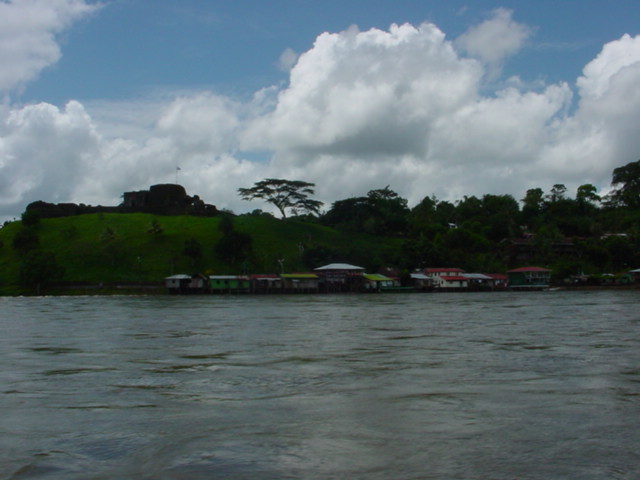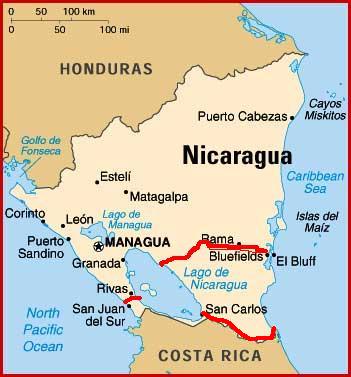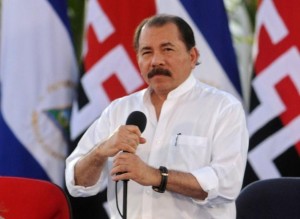 Investing in the Nicaragua Canal
Investing in the Nicaragua Canal
The government of Nicaragua wants to build a canal, claiming the project would create thousands of job and lift the country out of its poverty stricken state. The proposed canal would be three times the length of the Panama Canal and cost an estimated forty billion dollars. On June 13, 3013, the Nicaragua National Assembly ratified an exclusive agreement with Chinese businessman, Wang Jing to design, construct and maintain what many say has been the dream of the Nicaraguan people for 150 years.
Opposition to the canal say the project is a slap in the face. Twenty-one Nicaraguan organizations signed a manifesto stating Nicaragua is not for sale. Their contention is that President Daniel Ortega is utilizing the plans to build an inter-oceanic canal as a means of consolidating his economic power with the biggest fraud and robbery of national property the country has ever seen.
They raise several concerns. The HKND Group – the HK Nicaragua Canal Investment Company- would have exclusive rights over the development, operation and management of the canal for at least fifty years, with the possibility of extending these rights for fifty years more. These rights would include the development of ports, free trade zones, an International airport, and other infrastructure deemed necessary for the canal service.
Chairman, Wang Jing, has received a lot of skepticism. There is no indication that he has had any experience with Global Engineering beyond telecommunications. However, Jang states he has attracted International investors Jang claims to be an ordinary citizen with no affiliations with the Chinese communist government, party or military. “We don’t want to become an International joke,” stated Jing, in an interview with BBC News. “And we don’t want it to turn into an example of Chinese Investment failures.”
Wang is credited with turning the telecommunications company, Xinwei Telecom Enterprise Group into a flourishing industry, partly by expanding overseas, including investments in Nicaragua. Opponents claim, however, Nicaragua has seen very little of the $700 million Xinwei promised to invest in its communications system. Currently, he is the only public face behind the investment project.
Many analysts feel the canal will not be profitable. They point to the expansion of the Panama Canal, which will allow the post-Panamax ships to pass through its locks instead of traveling around Cape Horn. They also speculate on the feasibility of using the Northwest Passage, although the ownership of the passage has not yet been settled and the area is rarely ice free. Wang however, believes that shipping demands will only increase and there will be a need for an alternative canal in the near future.
Environmental Concerns
The proposed canal has also set off a string of environmental protests. The geography of Nicaragua consists of a very wide Caribbean coastal plain, with a slender range of mountains and volcanoes running through the center. The Pacific side is in the ring of fire, with the vast majority of the country’s nineteen volcanoes contained within the vicinity of Lake Nicaragua.
 Lake Nicaragua, also known as Lake Cocibolca or Mar Dulce, is the nineteenth largest lake in the world and the ninth largest in the Americas. The lake drains into the San Juan River, which flows east into the Caribbean.
Lake Nicaragua, also known as Lake Cocibolca or Mar Dulce, is the nineteenth largest lake in the world and the ninth largest in the Americas. The lake drains into the San Juan River, which flows east into the Caribbean.
Lake Nicaragua, or Cocibolca, as the inhabitants prefer to call it, is separated from the Pacific Ocean by a narrow strip of land. Within the lake are some of the world’s most unique species of fresh water marine life, including the world’s only known species of fresh water shark, sawfish and tarpon. Scientists believe that at one time the lake was a Pacific Bay that became land-locked through volcanic eruptions. As the water gradually sweetened, the marine species slowly adapted to fresh water.
Before the building of the Panama Canal, early commercial trade used the San Juan River to transport goods to Cocibolca, then to the Pacific side, via wagon trains. The proposal would once again make Cocibolca a main thoroughfare for the marine shipment of goods.
Opponents state the lake is a main water source for Nicaragua and that the lock system proposed would not only disturb the rare marine species, but eventually drain the lake of its fresh water supply.
Environmental Development or No Development
While environmental concerns should always be foremost in any large project that could affect water-sheds, bio-systems or animal and marine life habitats, the opposition to Nicaragua’s proposed canal is largely misinformed. Nicaragua is a water rich country. Its primary concern is not a lack of fresh water, but a primitive infrastructure that allows grey and black water to contaminate its fresh water supply. Thirty-two tons of raw sewage are dumped into Cocibolca every day. The biggest culprit is Pennwalt Chemical Corporation, although industry in general has been dumping its sewage into the lake for a great many years.
A test of Cocibolca’s waters led to the discovery that over half of the water samples taken were polluted by industrial waste. Because of its economic position, the newly independent country of Nicaragua does not have the funds for building effective water treatment facilities and proper waste disposal for the struggling country.
The Ortega administration wants to build an eco-canal that would disturb the natural environment as little as possible. The depth of Cocibolca already makes it possible to pass through the giant post-Panamex ships. Its greatest obstacles would be six sets of white water rapids along the San Juan river, and the dredging of some of the largest sandbars.
Costa Rica is already protesting the use of the San Juan, as the river flows through a hotly contested area along the Nicaragua/ Costa Rica border. As a concession, President Ortega has agreed that the planned canal would not be developed along the San Juan River for technical reasons.
The Panama Model
The building of the Panama Canal has been considered one of the greatest engineering feats of the modern day world. The 48 mile long water path cuts through the Continental Divide, and involved the construction of the Gatun Dam, then the largest dam in the world, along with an artificial lake. The canal essentially changed the entire geography of this region of Panama, dynamiting a path through the country’s mountainous backbone, excavating 200,000,000 tons of earth and diverting the River Chagres. The artificial lake now contains a number of islands with their own bio-systems, including the world famous Barro Colorado Island, used in scientific study of the tropical animal and plant life originating within the area.
Currently, Lake Gatun is Panama’s main source of fresh water. The lake is periodically replenished during the rain season. After nearly a hundred years of operation, canal operations are only now beginning to test the capacity of the lake to continue filling the locks for ship passage. The new construction underway to build a third water lane will include adding basins for collecting more water.
The Panama Canal greatly improved the quality of life for its citizens. Stagnant pools of water were drained and antiquated models for sewage replaced with updated waste disposal systems. Mosquito driven tropical diseases were cut back to a minimum or completely eradicated.
The natural lake, Cocibolca, is much larger than Lake Gatun. The region is also fed by up to 120 inches a year of tropical rains. Additionally, it has a sister lake, Managua, which is forty miles long and twenty-five miles wide. Severely polluted, the lake could benefit from modern waste disposal and sewage treatment facilities, but Nicaraguan pocketbooks are empty. The recovering country is the second poorest in Central America, next to Haiti.
Political Agenda
The United States has never been happy with Nicaraguan politics. As the country struggled to over-turn the rule of the Samoza dictatorship, beginning in the 1930’s, the US watched in consternation as the movement swelled in the late 1960’s, with a civil war that had replaced the Samoza regime forever by 1979.
The revolution highlighted two main areas of conflict. The Sandinistas dispossessed the wealthy American businessmen invested in the country, and began crafting a working model of democratic socialism. The country further augmented US hostilities with open support of Cuba. In retaliation, the US both legally and illegally funded the Contra-Sandinistas with military aid and mercenary soldiers. The war, which should have culminated with the removal of a corrupt dictator, dragged on for another ten years, killing thousands of Nicaraguan citizens and leaving the country completely bankrupt.
To this day, it’s difficult to find objective US reports on the political situation in Nicaragua. Despite the efforts of Sandinista President, Daniel Ortega to improve diplomatic relations, he stands accused of corruption and tyranny. One of the black points held against him was his re-election to a third term, despite a Constitutional law that allowed only two consecutive terms. With a 65% popularity rating, the Nicaragua Supreme Court amended the law to allow Ortega to serve a third consecutive term.
The People’s Survey
Ortega’s accusers claim the presidential elections were rigged, yet surveys show a continued popularity for the president who is trying to create a sovereign country on little to nothing. When asked, 73% of the people favored the canal project, while twelve percent either scratched their heads in befuddlement or stared off into the distance, according to the Nicaragua Dispatch. Many believe the canal project will double the country’s economic growth and triple the levels of formal employment.
Ortega states the adverse publicity is an attempt by the opposition to stir up bad publicity. He claims the 35% expressing disagreement with his policies are those who already have a stable income and high standard of living. Significantly, only three of the 21 signatures on the manifesto to remove Ortega are not affiliated with a secondary political party. They are the Confederation of Teachers (Confederacion de Maestros de la Educacion), the Permanent Commission on Human Rights (Comision Permanente de Derechos Humanos) and the Woman’s Movement (Movimento Autonomo de Mujeres). None of the organizations is an environmental group.
While it’s difficult not to sympathize with such worthwhile committee’s as human rights, teachers and the voices of women, there is a need to look realistically at Nicaragua’s dilemma. Only 54% of Nicaragua’s population was educated during the civil war. Only five percent of the population now remains unable to read and write. Unfortunately, education is still a driving need for the under-developed country. The average person has only a fourth grade education.
Critics state that Ortega’s educational plan involves teaching the population how to improve agriculture and create business plans that would benefit the country as a whole instead of building individual capital enterprise, yet the country as a whole is poverty stricken. In western countries, graduates receive masters in business administration, learning how to manage corporate interests on a global scale. Nicaragua is desperately in need of a competitive edge.
Human rights were demolished in the 1980’s when the vigorous campaign to remove the socialists from power destroyed the country. The country is now so poor, it can not even afford an adequate police service, and crime runs amok even in tourist areas. These crimes rarely involve murder; in fact, the murder rate is extremely low, but theft and burglary are common. The police are under-staffed, under-paid, and in many areas, non-existent.
Women are a powerhouse in Latin American politics. There have been nine women presidents in the Latin American countries since 1974, including one in Nicaragua; Violeta Chamorro, who served from 1990-1997. Chamorro was backed by the United States in her 1990 campaign against Ortega, with US sanctions lifted after her election. Chamorro came from a wealthy family, and was educated abroad, including in the United States.
Although “selling” a large portion of Nicaragua for the building of a canal seems a drastic measure, the United States owned the canal through Panama for over fifty years, before student protests and political unrest caused President Carter to agree on turning over the canal’s management to the Panama people. Until the Panama people asserted their independence, the United States was very much of the opinion they owned the country.
Final Counsel
Before condemning President Ortega, we need to reflect on our own policies of governing. Nicaragua is a country under duress. The United States, during its own time of duress, elected Franklin D. Roosevelt to the office of presidency four times. While critics continue to debate his strongly socialized views, Roosevelt helped lift the country out of the Great Depression through various bills that increased employment, insured retirement income and allowed land settlement through the Homestead Act. He was the only US president to complete three terms and begin a fourth before his death.
Nicaragua is a country with a vast number of natural resources. Beside being water rich, the volcanic ash soil is so fertile, it can be cultivated year round without the necessity of crop rotation. It also has vast amounts of timber and an abundance of marine life. Its mineral resources include gold, silver, copper, iron ore, lead, zinc and gypsum. It is prime real estate, yet the country does not have the economic resources for developing its potential.
It will take strong leadership and the combined efforts of its six million people to pull it up into the arena of a modern country with all the conveniences of advanced technology. It will take partnerships and investors who believe Nicaragua can compete in trade, manufacturing and industry. If it has chosen an alliance with China, it’s possible it sees this offer to develop a canal through the country as its only viable recourse.
The years have not been kind to Nicaragua, but it still clings to the hope of a brighter future. Instead of aligning ourselves as enemies of its natural desire for prosperity, we should extend the hand of friendship and demonstrate a desire for global peace. Perhaps in fifty years, it will follow the example of Panama and say, “enough. You have made your profits. Now it is time to take back our canal.”

[…] For more information, here is a great read […]
Interesting. Seems to me that water is life and possible environmental concerns should be looked at, By Nicaragua and nobody else. It stands to reason the traffic will bring a good deal of money to the struggling nation.
Grainne, I believe the environmental concerns should be based around the current conditions of Nicaragua’s water supply. They are not proposing a canal through a pristine lake. They are proposing one through water that is already heavily polluted. Currently, we have no idea what China proposes to do, but the funds initiated could help the country build a better infrastructure for waste disposal. Without funds, it’s a slow, plodding battle.
That the government of Nicaragua wants to build an adequate infrastructure, I have no doubts. They have already initiated a vigorous educational and public health program. Clean water and good health go hand in hand. Nicaragua faces many problems. It’s not perfect, but it has the energy of an innovative country trying out its new found independence. I wish for it the best in its endeavors.